Critical Analysis of Criminological Theories: Race, Emotion, and Crime
VerifiedAdded on 2023/06/12
|5
|1247
|240
Essay
AI Summary
This essay delves into various criminological theories, contrasting New Right and New Left Realist perspectives on crime, examining their approaches to addressing criminal behavior and societal disorder. It critically analyzes the treatment of racial minorities within the criminal justice system, drawing upon structuralist arguments from critical criminologists who highlight power imbalances and systemic biases. Furthermore, the essay explores the role of emotion in criminal decision-making, contrasting it with earlier rational choice theories and emphasizing the importance of considering emotional factors for a comprehensive understanding of crime. The document provides insights into how crime and its enforcement are connected to power dynamics, offering a nuanced view beyond traditional top-down models. This analysis is intended to provide students with a broader understanding of human criminal behavior and the complex interplay of social, economic, and psychological factors influencing crime.
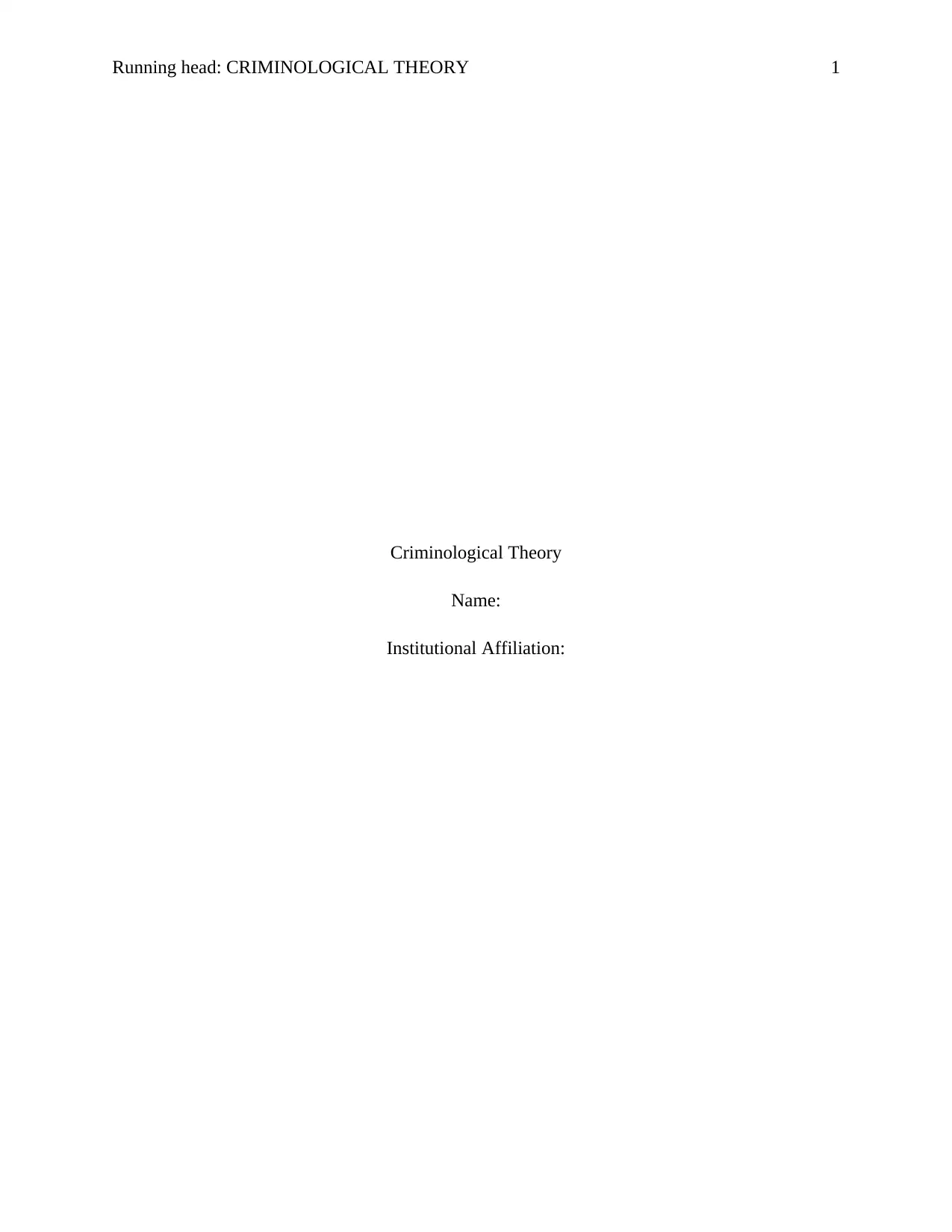
Running head: CRIMINOLOGICAL THEORY 1
Criminological Theory
Name:
Institutional Affiliation:
Criminological Theory
Name:
Institutional Affiliation:
Paraphrase This Document
Need a fresh take? Get an instant paraphrase of this document with our AI Paraphraser
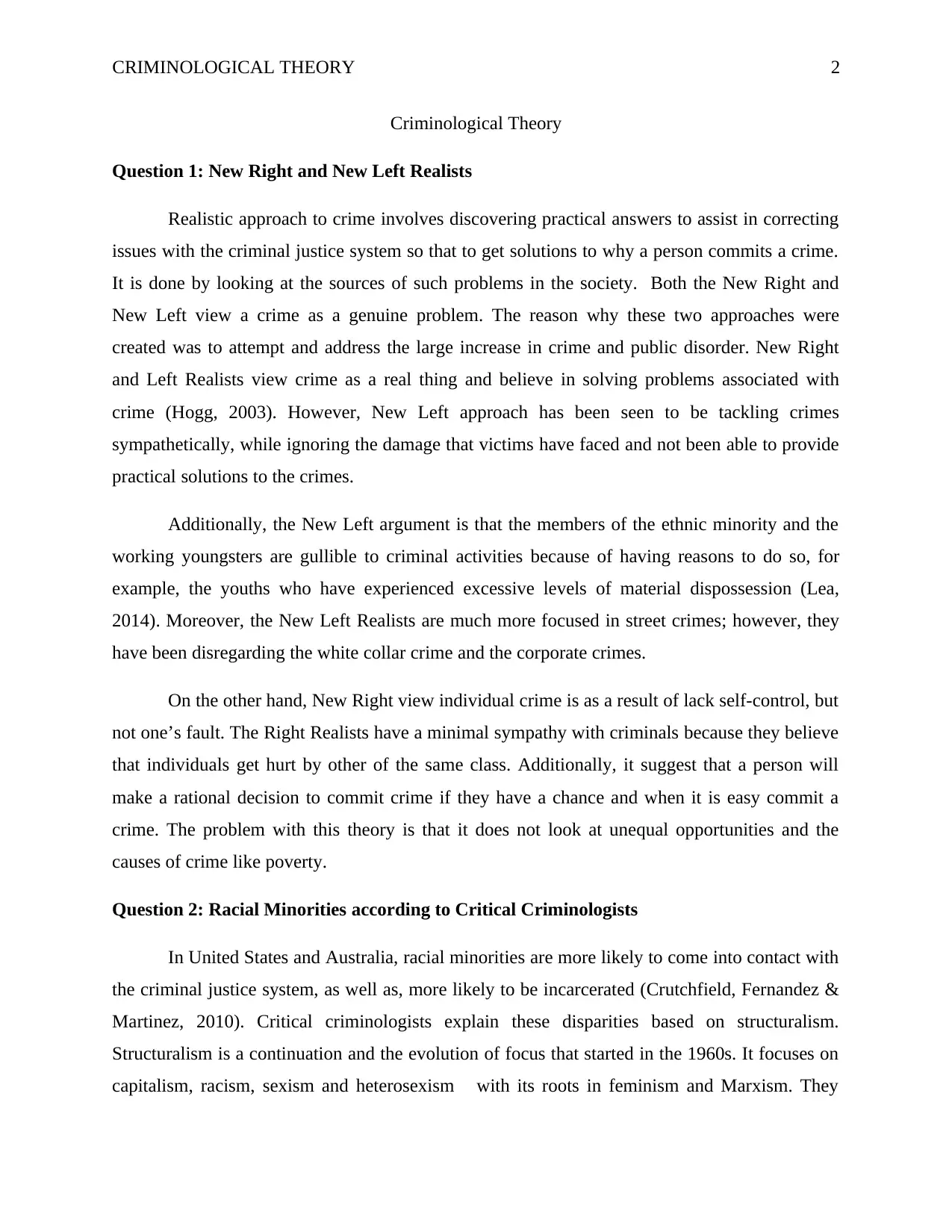
CRIMINOLOGICAL THEORY 2
Criminological Theory
Question 1: New Right and New Left Realists
Realistic approach to crime involves discovering practical answers to assist in correcting
issues with the criminal justice system so that to get solutions to why a person commits a crime.
It is done by looking at the sources of such problems in the society. Both the New Right and
New Left view a crime as a genuine problem. The reason why these two approaches were
created was to attempt and address the large increase in crime and public disorder. New Right
and Left Realists view crime as a real thing and believe in solving problems associated with
crime (Hogg, 2003). However, New Left approach has been seen to be tackling crimes
sympathetically, while ignoring the damage that victims have faced and not been able to provide
practical solutions to the crimes.
Additionally, the New Left argument is that the members of the ethnic minority and the
working youngsters are gullible to criminal activities because of having reasons to do so, for
example, the youths who have experienced excessive levels of material dispossession (Lea,
2014). Moreover, the New Left Realists are much more focused in street crimes; however, they
have been disregarding the white collar crime and the corporate crimes.
On the other hand, New Right view individual crime is as a result of lack self-control, but
not one’s fault. The Right Realists have a minimal sympathy with criminals because they believe
that individuals get hurt by other of the same class. Additionally, it suggest that a person will
make a rational decision to commit crime if they have a chance and when it is easy commit a
crime. The problem with this theory is that it does not look at unequal opportunities and the
causes of crime like poverty.
Question 2: Racial Minorities according to Critical Criminologists
In United States and Australia, racial minorities are more likely to come into contact with
the criminal justice system, as well as, more likely to be incarcerated (Crutchfield, Fernandez &
Martinez, 2010). Critical criminologists explain these disparities based on structuralism.
Structuralism is a continuation and the evolution of focus that started in the 1960s. It focuses on
capitalism, racism, sexism and heterosexism with its roots in feminism and Marxism. They
Criminological Theory
Question 1: New Right and New Left Realists
Realistic approach to crime involves discovering practical answers to assist in correcting
issues with the criminal justice system so that to get solutions to why a person commits a crime.
It is done by looking at the sources of such problems in the society. Both the New Right and
New Left view a crime as a genuine problem. The reason why these two approaches were
created was to attempt and address the large increase in crime and public disorder. New Right
and Left Realists view crime as a real thing and believe in solving problems associated with
crime (Hogg, 2003). However, New Left approach has been seen to be tackling crimes
sympathetically, while ignoring the damage that victims have faced and not been able to provide
practical solutions to the crimes.
Additionally, the New Left argument is that the members of the ethnic minority and the
working youngsters are gullible to criminal activities because of having reasons to do so, for
example, the youths who have experienced excessive levels of material dispossession (Lea,
2014). Moreover, the New Left Realists are much more focused in street crimes; however, they
have been disregarding the white collar crime and the corporate crimes.
On the other hand, New Right view individual crime is as a result of lack self-control, but
not one’s fault. The Right Realists have a minimal sympathy with criminals because they believe
that individuals get hurt by other of the same class. Additionally, it suggest that a person will
make a rational decision to commit crime if they have a chance and when it is easy commit a
crime. The problem with this theory is that it does not look at unequal opportunities and the
causes of crime like poverty.
Question 2: Racial Minorities according to Critical Criminologists
In United States and Australia, racial minorities are more likely to come into contact with
the criminal justice system, as well as, more likely to be incarcerated (Crutchfield, Fernandez &
Martinez, 2010). Critical criminologists explain these disparities based on structuralism.
Structuralism is a continuation and the evolution of focus that started in the 1960s. It focuses on
capitalism, racism, sexism and heterosexism with its roots in feminism and Marxism. They
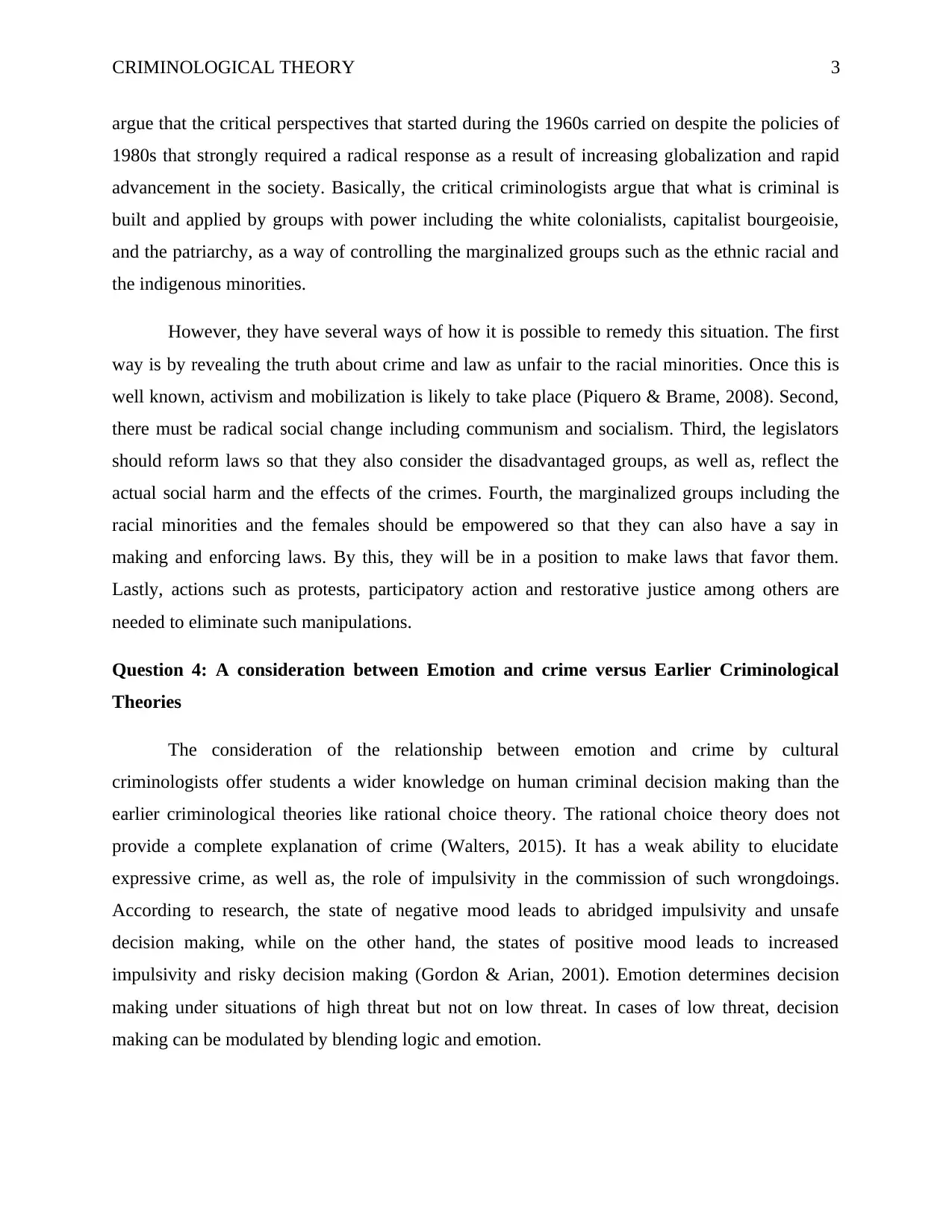
CRIMINOLOGICAL THEORY 3
argue that the critical perspectives that started during the 1960s carried on despite the policies of
1980s that strongly required a radical response as a result of increasing globalization and rapid
advancement in the society. Basically, the critical criminologists argue that what is criminal is
built and applied by groups with power including the white colonialists, capitalist bourgeoisie,
and the patriarchy, as a way of controlling the marginalized groups such as the ethnic racial and
the indigenous minorities.
However, they have several ways of how it is possible to remedy this situation. The first
way is by revealing the truth about crime and law as unfair to the racial minorities. Once this is
well known, activism and mobilization is likely to take place (Piquero & Brame, 2008). Second,
there must be radical social change including communism and socialism. Third, the legislators
should reform laws so that they also consider the disadvantaged groups, as well as, reflect the
actual social harm and the effects of the crimes. Fourth, the marginalized groups including the
racial minorities and the females should be empowered so that they can also have a say in
making and enforcing laws. By this, they will be in a position to make laws that favor them.
Lastly, actions such as protests, participatory action and restorative justice among others are
needed to eliminate such manipulations.
Question 4: A consideration between Emotion and crime versus Earlier Criminological
Theories
The consideration of the relationship between emotion and crime by cultural
criminologists offer students a wider knowledge on human criminal decision making than the
earlier criminological theories like rational choice theory. The rational choice theory does not
provide a complete explanation of crime (Walters, 2015). It has a weak ability to elucidate
expressive crime, as well as, the role of impulsivity in the commission of such wrongdoings.
According to research, the state of negative mood leads to abridged impulsivity and unsafe
decision making, while on the other hand, the states of positive mood leads to increased
impulsivity and risky decision making (Gordon & Arian, 2001). Emotion determines decision
making under situations of high threat but not on low threat. In cases of low threat, decision
making can be modulated by blending logic and emotion.
argue that the critical perspectives that started during the 1960s carried on despite the policies of
1980s that strongly required a radical response as a result of increasing globalization and rapid
advancement in the society. Basically, the critical criminologists argue that what is criminal is
built and applied by groups with power including the white colonialists, capitalist bourgeoisie,
and the patriarchy, as a way of controlling the marginalized groups such as the ethnic racial and
the indigenous minorities.
However, they have several ways of how it is possible to remedy this situation. The first
way is by revealing the truth about crime and law as unfair to the racial minorities. Once this is
well known, activism and mobilization is likely to take place (Piquero & Brame, 2008). Second,
there must be radical social change including communism and socialism. Third, the legislators
should reform laws so that they also consider the disadvantaged groups, as well as, reflect the
actual social harm and the effects of the crimes. Fourth, the marginalized groups including the
racial minorities and the females should be empowered so that they can also have a say in
making and enforcing laws. By this, they will be in a position to make laws that favor them.
Lastly, actions such as protests, participatory action and restorative justice among others are
needed to eliminate such manipulations.
Question 4: A consideration between Emotion and crime versus Earlier Criminological
Theories
The consideration of the relationship between emotion and crime by cultural
criminologists offer students a wider knowledge on human criminal decision making than the
earlier criminological theories like rational choice theory. The rational choice theory does not
provide a complete explanation of crime (Walters, 2015). It has a weak ability to elucidate
expressive crime, as well as, the role of impulsivity in the commission of such wrongdoings.
According to research, the state of negative mood leads to abridged impulsivity and unsafe
decision making, while on the other hand, the states of positive mood leads to increased
impulsivity and risky decision making (Gordon & Arian, 2001). Emotion determines decision
making under situations of high threat but not on low threat. In cases of low threat, decision
making can be modulated by blending logic and emotion.
⊘ This is a preview!⊘
Do you want full access?
Subscribe today to unlock all pages.

Trusted by 1+ million students worldwide
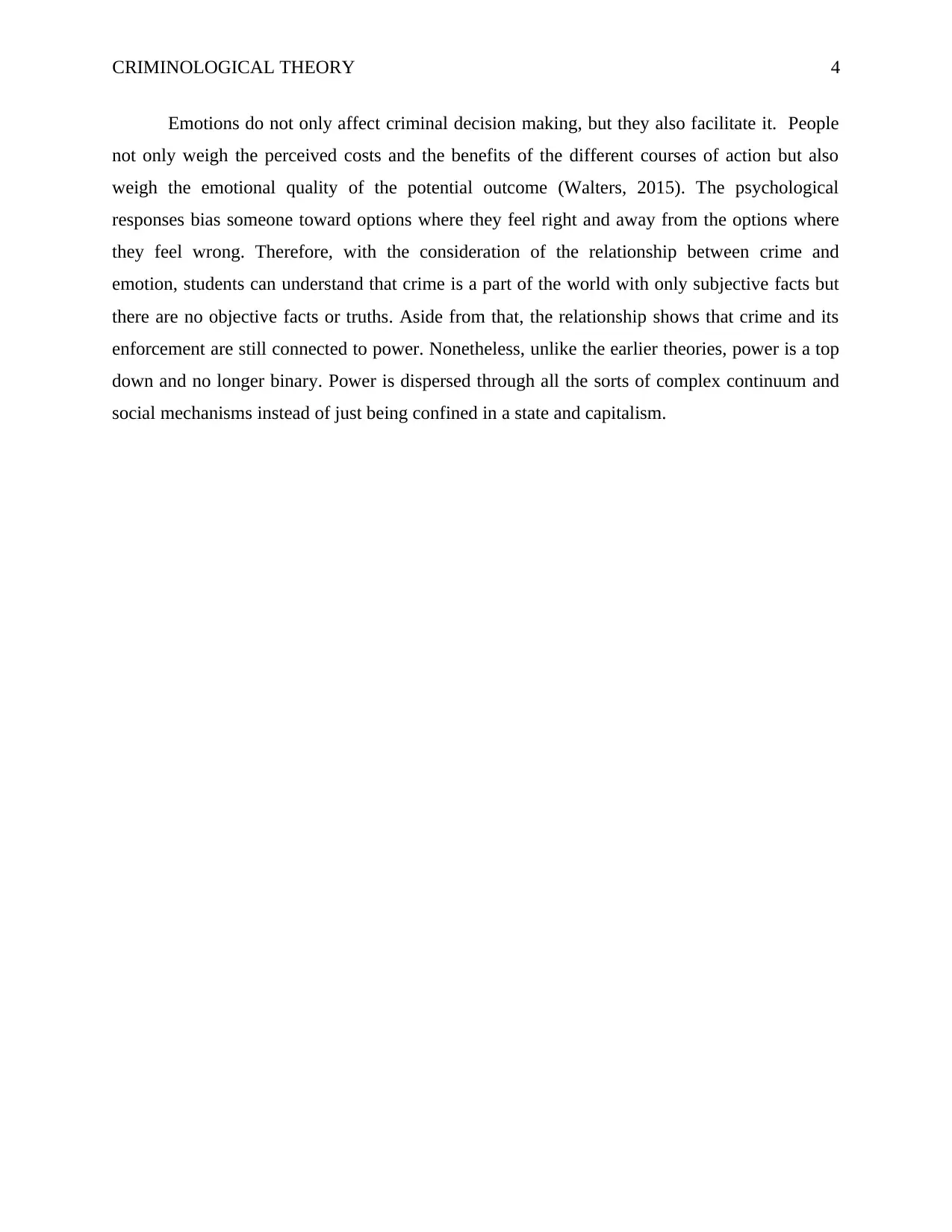
CRIMINOLOGICAL THEORY 4
Emotions do not only affect criminal decision making, but they also facilitate it. People
not only weigh the perceived costs and the benefits of the different courses of action but also
weigh the emotional quality of the potential outcome (Walters, 2015). The psychological
responses bias someone toward options where they feel right and away from the options where
they feel wrong. Therefore, with the consideration of the relationship between crime and
emotion, students can understand that crime is a part of the world with only subjective facts but
there are no objective facts or truths. Aside from that, the relationship shows that crime and its
enforcement are still connected to power. Nonetheless, unlike the earlier theories, power is a top
down and no longer binary. Power is dispersed through all the sorts of complex continuum and
social mechanisms instead of just being confined in a state and capitalism.
Emotions do not only affect criminal decision making, but they also facilitate it. People
not only weigh the perceived costs and the benefits of the different courses of action but also
weigh the emotional quality of the potential outcome (Walters, 2015). The psychological
responses bias someone toward options where they feel right and away from the options where
they feel wrong. Therefore, with the consideration of the relationship between crime and
emotion, students can understand that crime is a part of the world with only subjective facts but
there are no objective facts or truths. Aside from that, the relationship shows that crime and its
enforcement are still connected to power. Nonetheless, unlike the earlier theories, power is a top
down and no longer binary. Power is dispersed through all the sorts of complex continuum and
social mechanisms instead of just being confined in a state and capitalism.
Paraphrase This Document
Need a fresh take? Get an instant paraphrase of this document with our AI Paraphraser
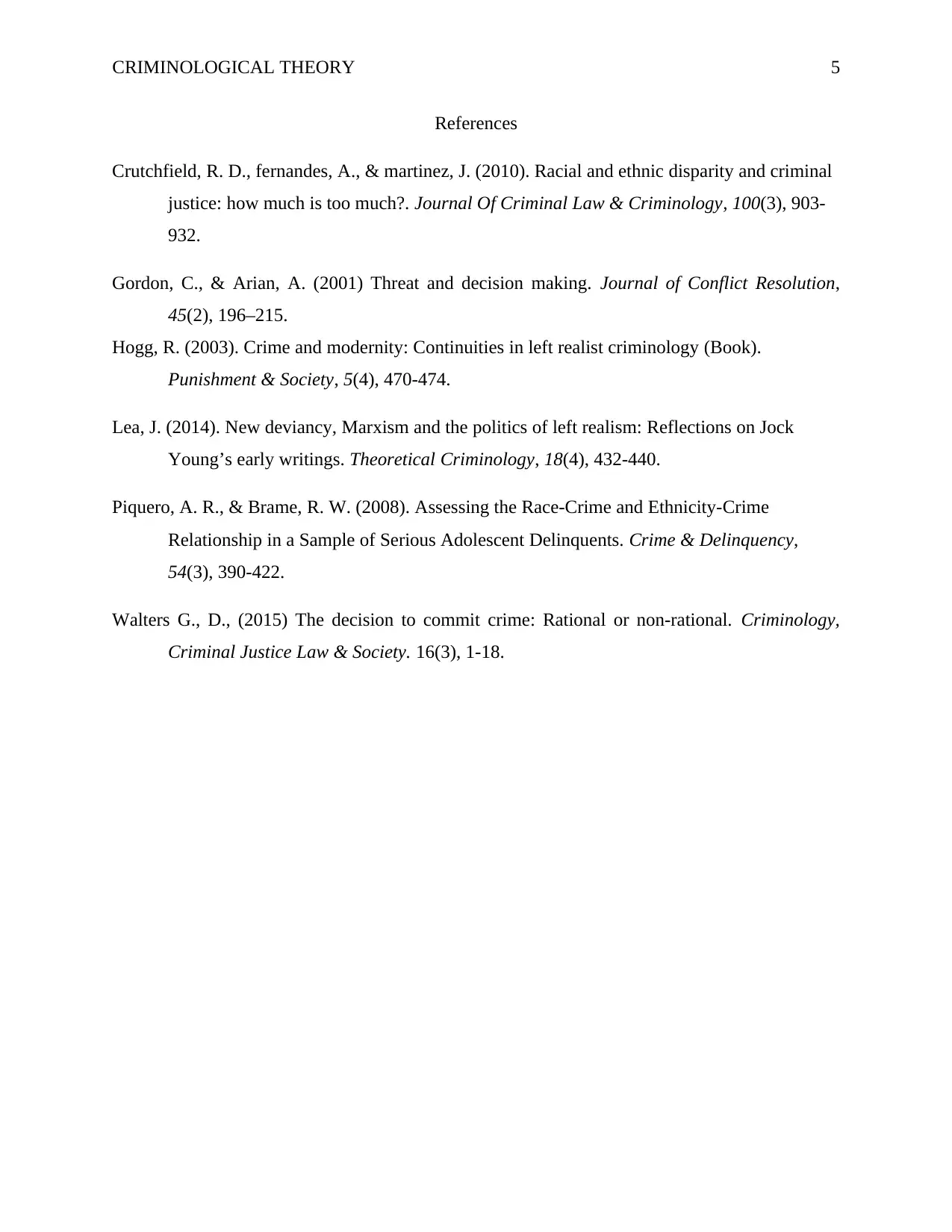
CRIMINOLOGICAL THEORY 5
References
Crutchfield, R. D., fernandes, A., & martinez, J. (2010). Racial and ethnic disparity and criminal
justice: how much is too much?. Journal Of Criminal Law & Criminology, 100(3), 903-
932.
Gordon, C., & Arian, A. (2001) Threat and decision making. Journal of Conflict Resolution,
45(2), 196–215.
Hogg, R. (2003). Crime and modernity: Continuities in left realist criminology (Book).
Punishment & Society, 5(4), 470-474.
Lea, J. (2014). New deviancy, Marxism and the politics of left realism: Reflections on Jock
Young’s early writings. Theoretical Criminology, 18(4), 432-440.
Piquero, A. R., & Brame, R. W. (2008). Assessing the Race-Crime and Ethnicity-Crime
Relationship in a Sample of Serious Adolescent Delinquents. Crime & Delinquency,
54(3), 390-422.
Walters G., D., (2015) The decision to commit crime: Rational or non-rational. Criminology,
Criminal Justice Law & Society. 16(3), 1-18.
References
Crutchfield, R. D., fernandes, A., & martinez, J. (2010). Racial and ethnic disparity and criminal
justice: how much is too much?. Journal Of Criminal Law & Criminology, 100(3), 903-
932.
Gordon, C., & Arian, A. (2001) Threat and decision making. Journal of Conflict Resolution,
45(2), 196–215.
Hogg, R. (2003). Crime and modernity: Continuities in left realist criminology (Book).
Punishment & Society, 5(4), 470-474.
Lea, J. (2014). New deviancy, Marxism and the politics of left realism: Reflections on Jock
Young’s early writings. Theoretical Criminology, 18(4), 432-440.
Piquero, A. R., & Brame, R. W. (2008). Assessing the Race-Crime and Ethnicity-Crime
Relationship in a Sample of Serious Adolescent Delinquents. Crime & Delinquency,
54(3), 390-422.
Walters G., D., (2015) The decision to commit crime: Rational or non-rational. Criminology,
Criminal Justice Law & Society. 16(3), 1-18.
1 out of 5
Related Documents
Your All-in-One AI-Powered Toolkit for Academic Success.
+13062052269
info@desklib.com
Available 24*7 on WhatsApp / Email
![[object Object]](/_next/static/media/star-bottom.7253800d.svg)
Unlock your academic potential
Copyright © 2020–2025 A2Z Services. All Rights Reserved. Developed and managed by ZUCOL.





